Bushmaster Snake
- December 15, 2023
- 0 comment
The Bushmaster, scientifically known as Lachesis, is a genus of venomous pit vipers inhabiting the dense forests of Central and South America. Renowned as one of the longest venomous snakes in the world, the Bushmaster has captured the fascination of herpetologists and enthusiasts alike.

With its impressive length that can exceed 3 meters, distinctive heat-sensing pits, and cryptic coloration, this serpent is a master of camouflage, blending seamlessly into its natural surroundings. The Bushmaster’s venom is potent, primarily hemotoxic, causing tissue damage and disrupting blood clotting.

Despite its formidable reputation, the snake is typically reclusive and avoids human encounters, relying on its cryptic behavior to remain concealed. Conservation efforts are essential for these elusive creatures due to habitat loss and the potential threat posed by human activities. Studying the Bushmaster is crucial not only for understanding its ecological role but also for developing effective antivenom to mitigate the impact of its venom on human health.
| Attribute | Description |
|---|---|
| Scientific Name | Lachesis (Genus) |
| Habitat | Dense forests of Central and South America |
| Size | Can exceed 3 meters in length |
| Venom Type | Primarily hemotoxic |
| Venom Effects | Causes tissue damage and disrupts blood clotting |
| Physical Features | Impressive length, heat-sensing pits, cryptic coloration |
| Behavior | Typically reclusive, avoids human encounters |
| Conservation Status | Faces threats from habitat loss and human activities |
| Role in Ecosystem | Important for maintaining ecological balance by controlling prey populations |
| Significance | Renowned as one of the longest venomous snakes; crucial for scientific study to develop effective antivenom for human health protection |
| Human Interaction | Generally non-aggressive unless provoked; bites can be dangerous, and medical attention is essential in the case of envenomation |
| Conservation Efforts | Necessary to address habitat loss and mitigate potential conflicts between the snake and human activities |
| Notable Characteristics | Master of camouflage, blends seamlessly into the environment, making it challenging to spot |
Botanical Beauty of “Bushmaster”
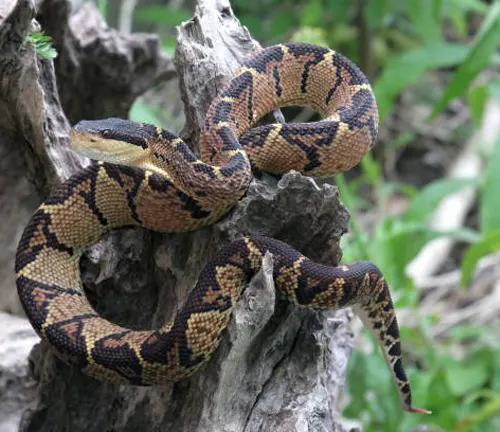
The Bushmaster, belonging to the genus Lachesis, is a captivating serpent that graces the dense forests of Central and South America. Beyond its venomous reputation, the Bushmaster is a testament to the beauty found in the intricate world of reptiles. Its physical features, such as an impressive length that can exceed three meters, heat-sensing pits, and cryptic coloration, contribute to its allure. This article explores the botanical beauty of the Bushmaster, highlighting the aesthetic elements that make it a fascinating subject for study and admiration.
Venomous or Not Venomous?
One of the most debated aspects of the Bushmaster snake is its venomous nature. Dive into the intricacies of its venom, primarily hemotoxic, and examine the effects it has on its prey. Explore the common misconceptions about its venomous capabilities and unravel the truth behind the reputation. This section aims to provide a balanced perspective on the Bushmaster’s venom, shedding light on its role in the snake’s survival and its potential impact on human interactions.

Ecological Importance
Delve into the ecological role played by the Bushmaster in its natural habitat. From controlling prey populations to contributing to the delicate balance of the ecosystem, the Bushmaster is more than just a formidable predator. Understand how its presence shapes the dynamics of the forest ecosystem and why conservation efforts are crucial to maintain this delicate equilibrium.
Habitat and Behavior

Explore the secretive life of the Bushmaster by examining its preferred habitats and behavior. Uncover the reasons behind its reclusive nature and discover the fascinating ways in which it adapts to its surroundings. From cryptic coloration to strategic hunting techniques, this section provides insights into the daily life and habits of the elusive Bushmaster.
Art and Culture
Beyond the scientific realm, the Bushmaster has found its place in art and culture. From indigenous myths to contemporary art, this section explores how the snake has influenced human creativity. Discover the symbolism attached to the Bushmaster in various cultures and appreciate its significance in artistic expressions.
Survival
Survival in the wild is a challenge, and the Bushmaster has evolved unique strategies to thrive. Examine its survival mechanisms, from efficient hunting techniques to reproductive strategies. Gain a deeper understanding of how this species has adapted to its environment and overcome the challenges of its natural world.
Conservation
As with many species, the Bushmaster faces threats to its existence. Explore the conservation efforts aimed at preserving its habitat and ensuring its survival. Understand the role of conservationists and communities in safeguarding this enigmatic snake and the broader biodiversity of the ecosystems it inhabits.
Common Food
Uncover the dietary preferences of the Bushmaster by examining its common food sources. From small mammals to birds, the snake’s menu plays a vital role in shaping its ecological impact. This section sheds light on the intricate web of relationships between the Bushmaster and its prey, showcasing the interconnectedness of life in the wild.

Benefits
Conclude the exploration of the Bushmaster by highlighting the benefits it brings to its ecosystem and, indirectly, to humans. From controlling pest populations to contributing to the overall health of the forest, the Bushmaster plays a valuable role in the intricate tapestry of life. Understand why preserving this species is not only essential for its well-being but also for the well-being of the ecosystems it inhabits.
Different Species
Lachesis muta
(Common Bushmaster or Mute Bushmaster)
This is the most well-known species and is found in various regions of Central and South America. It is recognized for its large size and potent hemotoxic venom.

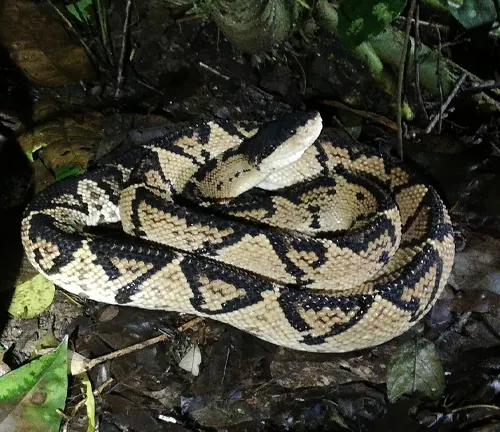
Lachesis melanocephala
(Black-headed Bushmaster)
This species is known for its distinctive black head and is found in parts of South America, including Ecuador and Peru.
Lachesis stenophrys
(Central American Bushmaster)
This species is native to Central America, including regions of Honduras and Nicaragua. It is characterized by its slender body and is considered one of the smaller species within the genus.

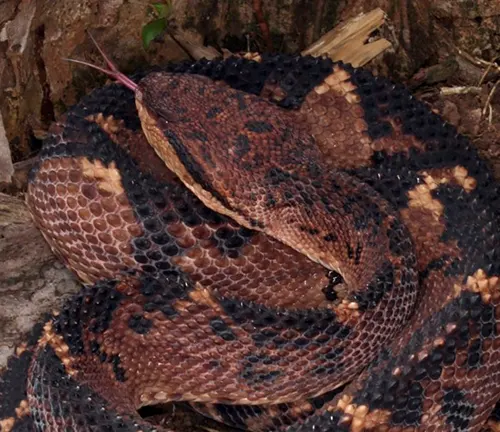
Lachesis acrochorda
(Honduran Bushmaster)
Endemic to Honduras, this species is recognized for its specific geographical distribution and certain morphological characteristics that differentiate it from other Bushmasters.
Frequently Asked Questions (FAQs)
- What is a Bushmaster snake?
The Bushmaster is a large venomous snake belonging to the genus Lachesis, found in the dense forests of Central and South America. - How venomous is the Bushmaster?
The Bushmaster is highly venomous, with its venom primarily being hemotoxic. It can cause tissue damage and disrupt blood clotting. - Are Bushmasters aggressive towards humans?
Bushmasters are typically reclusive and avoid human encounters. They are not known to be aggressive unless provoked. - What is the habitat of the Bushmaster?
Bushmasters inhabit dense forests in Central and South America, where their cryptic coloration helps them blend into the environment. - What is the size of a Bushmaster snake?
Bushmasters can exceed three meters in length, making them one of the longest venomous snakes in the world. - What is the ecological importance of Bushmasters?
Bushmasters play a crucial role in controlling prey populations and contributing to the balance of their forest ecosystems. - Are there different species of Bushmasters?
Yes, there are several species within the Lachesis genus, including the Common Bushmaster, Black-headed Bushmaster, Central American Bushmaster, and Honduran Bushmaster. - Do Bushmasters have any cultural significance?
Yes, Bushmasters hold cultural significance in various indigenous myths and have inspired artistic expressions in different cultures. - How do Bushmasters hunt and survive in the wild?
Bushmasters use a sit-and-wait hunting strategy, relying on their cryptic coloration to ambush prey. They have adapted well to their environments for survival. - Are there conservation concerns for Bushmasters?
Yes, habitat loss and human activities pose threats to Bushmasters. Conservation efforts are crucial to ensure their survival and the health of their ecosystems. - What is the lifespan of a Bushmaster snake?
The exact lifespan of Bushmasters in the wild is not well-documented, but in captivity, they can live for over 20 years. - Can Bushmaster venom be used for medical purposes?
While the venom is potent and poses a danger, it is also valuable for scientific research. Studying the venom can contribute to the development of antivenom and medical treatments.





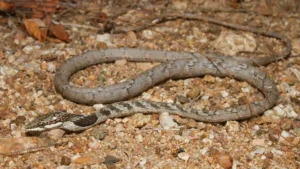
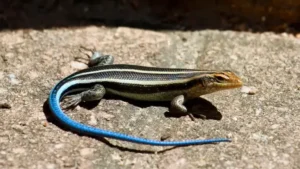
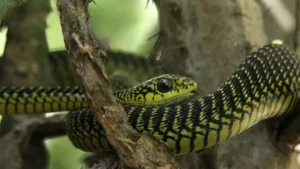

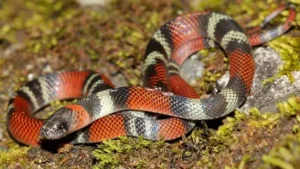

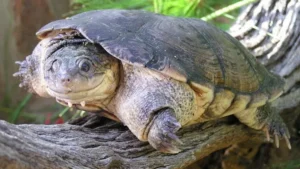

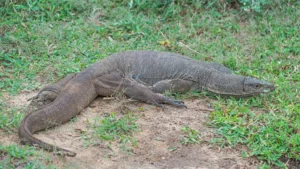
Leave your comment